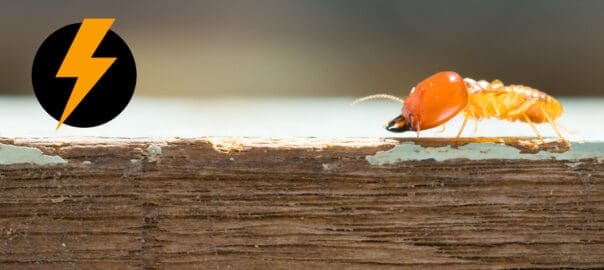The thought of termites can make your skin crawl, especially if you think about them invading your home. But are termites in Oregon a serious problem?
Yes. Because of the damp, humid spring weather in Oregon, termites are a common pest. They love the weather conditions in the Pacific Northwest. Frequent rains can cause excess moisture in homes, which they find extremely inviting. Here’s what you need to know about termites in Oregon and how you can prevent an invasion.
Termite Tidbits
There are over two thousand different species of termites, with over forty species in the United States alone. Termites are known as silent destroyers since they may be secretly hiding and thriving in your home without any immediate signs of damage. They may be silent, but they are costly. These wood-munching pests cause billions of dollars of damage each year in the States.

There are four types of termites, but the most common in Oregon are the Pacific dampwood termite and the Western Subterranean termite. While each species thrives in different climates and eats different food sources, they all need four things to survive (which all homes provide):
- Food
- Moisture
- Shelter
- Optimal temperature
Western Subterranean Termites: Silent House Invaders
These elusive insects are native to the Western part of the United States, making Oregon one of their natural habitats. They thrive in the moist Pacific Northwest climate, which provides ideal conditions for them.
How to Spot a Western Subterranean Termite
The Western Subterranean termite has a discreet appearance. It’s small, measuring about 1/8 to 3/8 inches in length, and is creamy white to pale brown in color, with a soft body.
Eating Habits
These termites are notorious for their wood-devouring tendencies. They feed on cellulose, a component found in wood and plant materials. Their relentless appetite for wood makes them a significant threat to homes.
Mating Habits
Western Subterranean termite groups have a simple and effective mating ritual. They swarm in late winter or early spring, during which winged reproductive termites emerge from their colonies to mate. After mating, they shed their wings and search for suitable locations to establish new colonies.
Subterranean termites live in large colonies with various castes, including workers, soldiers, and reproductives (kings and queens). A single colony can contain hundreds of thousands of termites.
How They Gain Access to Homes
- Soil-to-wood contact. They build mud tubes, which serve as protected pathways, allowing them to access wooden structures from the soil.
- Cracks and gaps. Termites can enter through even the tiniest cracks or gaps in a home’s foundation.
- Cellulose-rich material. If your home contains untreated wood or cellulose-rich materials, it can attract termites.
Eliminating Home Infestations
If you suspect a Subterranean termite infestation, you need to act fast, whether through DIY solutions or professional methods:
- Remove infested wood. Remove and replace infested wood to prevent the colony from spreading.
- Boric acid. A boric acid and water mixture can be applied to termite-infested wood as a DIY treatment.
- Soil treatment. Professional pest control companies can treat the soil around your home’s foundation to create a barrier that repels termites.
- Baiting systems. Termite bait stations can be installed around your property to attract and eliminate the termite colony.
- Fumigation. In severe cases, fumigation may be necessary to eliminate termites from the entire structure.
Western Subterranean termites are the most destructive termites in Oregon, causing expensive damage to homes and buildings by destroying foundations, wooden support beams, plastic plumbing pipes, subflooring, and insulation. These tiny terrors can be even harder to discover since they typically live underground or near the base of homes. Preventive measures, DIY methods, and professional help can ensure your home remains termite-free.
Dampwood Termites: The Moisture-Loving Home Invaders
Dampwood termites may not be as notorious as their Subterranean cousins, but they also pose a threat to homes, especially in damp regions like Oregon. Let’s dive into their world, from their appearance to their habits, and how to keep them from making your home their own.
How to Spot a Dampwood Termite
Dampwood termites have distinctive characteristics. The Pacific dampwood termite is the largest of the common Northwest termite species. It is larger than a Subterranean termite, with an adult dampwood termite reaching up to one inch in length. A dampwood termite’s color varies from light to dark brown, with a robust cylindrical body.
Eating Habits
Dampwood termites, as their name suggests, primarily feed on moist wood. They are drawn to wood with high moisture content, often resulting from contact with the ground or exposure to leaks. Unlike many other termite species, dampwood termites don’t frequently infest buildings, showing a preference for more natural wood sources.
Mating Habits
Dampwood termite species have a straightforward mating ritual. Typically, swarms of winged reproductive termites emerge from their colonies during the spring or summer. After mating, they shed their wings and seek out suitable locations to establish new colonies.
Dampwood termite colonies are relatively small compared to those of Subterranean termites. They typically consist of a few hundred to a few thousand termites, often residing in decaying wood.
How They Gain Access to Homes
Unlike other termites, these pests don’t need contact with soil to make their way into structures. Dampwood termite entry points differ from those of Subterranean termites:
- Wood with high moisture. They are attracted to damp or water-damaged wood, so homes with moisture issues are more susceptible. Any condition that leads to moisture buildup in wood creates an invitation to invade. They break down the dead wood, returning nutrients to the soil—great for the environment, but not so great for your home.
- Cracks and gaps. They can enter through cracks or gaps in a home’s foundation or walls.
- Vents and roof leaks. Dampwood termites may enter through attic vents or roof leaks, as these areas are also prone to moisture.
Eliminating Home Infestations
Damp wood termites can cause significant damage, especially when you don’t reach out to a pest control professional experienced in termite control. Understanding their appearance, habits, and how to protect your home from them is essential. By addressing moisture issues, regularly inspecting wood, and seeking professional termite control when needed, you can keep your home safe from these moisture-loving invaders. Don’t let damp wood termites turn your home into a waterlogged buffet!
If you suspect dampwood-termite activity, swift action is crucial. If you plan to go the DIY route, remove and replace any infested wood to prevent the colony from expanding. Continue moisture-control efforts to discourage further infestation. If you need professional methods, consult a pest control professional to assess the extent of infestation and determine appropriate treatment, which may involve using termiticides or fumigation.
Signs of Termite Trouble
Termites are sneaky little insects that can be difficult to detect if you don’t know what to look for. However, there are usually telltale signs that let you know you may have underlying termite activity:
- Damaged or hollow-sounding wood. Wood damage can be found below and behind surfaces like walls and floors, often caused by termites chewing through wood, in search of cellulose. This leaves behind long grooves, which, over time, weaken the wood and cause structural damage. The wood may have a hollow or empty sound.
- Piles of wings. If you notice discarded wings found near closed doors and windows, this could be a sign of termites. Discarded wings occur when termites swarm to mate and start new colonies then shed their wings as these are no longer needed.
- Mud tubes/tunnels. Mud tubes are small tunnels that are found around termite nests located where the ground meets your home or in structures like sheds. Subterranean termites need moisture to survive. These tubes provide shelter and moisture while they forage up to their food source, typically your home.
- Blisters in wood floors. Subterranean termites can damage the subfloor, which may make it appear as if your wood floors have water damage.
If you notice these warning signs, it’s time to call a professional pest control company immediately. While Bug Zappers Pest Control doesn’t treat for termites, we do offer pest control services that can help spot issues early, potentially saving you thousands of dollars worth of termite damage.
Preventing Termite Activity
Termite treatment should always be left to professional pest control companies, but you can take these steps to prevent termite problems.
- Address any leaks or sources of moisture in your home promptly, including fixing roof leaks and ensuring proper drainage. Make sure your crawl space is properly ventilated with a good vapor barrier.
- Regularly inspect and replace any wood that has signs of water damage or rot.
- Ensure good ventilation in attics, crawl spaces, and basements to prevent excessive moisture buildup.
- Consider using termite-resistant building materials in moisture-prone areas.
- Keep gutters and downspouts free of debris.
- Install screens on exterior vents.
- Store firewood and lumber away from your home.
- Keep shrubbery near your home trimmed, allowing at least twelve inches between the shrubbery and exterior.
- Build a wall to create airflow.
- Use pine needles (which are less appealing to termites) instead of mulch.
- Consider professional soil treatment to create a protective barrier around your home’s foundation.
- Eliminate any direct contact between wood and soil by raising wooden structures above ground level.
- When building or renovating, use termite-resistant or treated wood for construction.
- Regularly inspect and seal any cracks, gaps, or openings in your home’s foundation and exterior.
Out of Solutions for Termite Control? Call Us Now!
Your home is your sanctuary, and you want to keep it pest-free. The best offense is a good defense against termite damage. Our professionally trained, knowledgeable team at Bug Zapper Pest Control is ready to be your defense. Contact us today!
Not sure when it’s time to call in the pros? Here are six tips to let you know it’s time to pick up the phone. Learn more about how we can help you with termite control.
Call or text 541-636-1146 for a pest inspection today!



 Pacific Northwest Rodents Part 2 – Mice
Pacific Northwest Rodents Part 2 – Mice Boxelder Bugs and Stinkbugs
Boxelder Bugs and Stinkbugs Town and Country Pest: Your Local Pest Solutions
Town and Country Pest: Your Local Pest Solutions Termites in Oregon: Are Termites a Problem in Oregon?
Termites in Oregon: Are Termites a Problem in Oregon? How to Get Rid of Bed Bugs – For GOOD!
How to Get Rid of Bed Bugs – For GOOD!